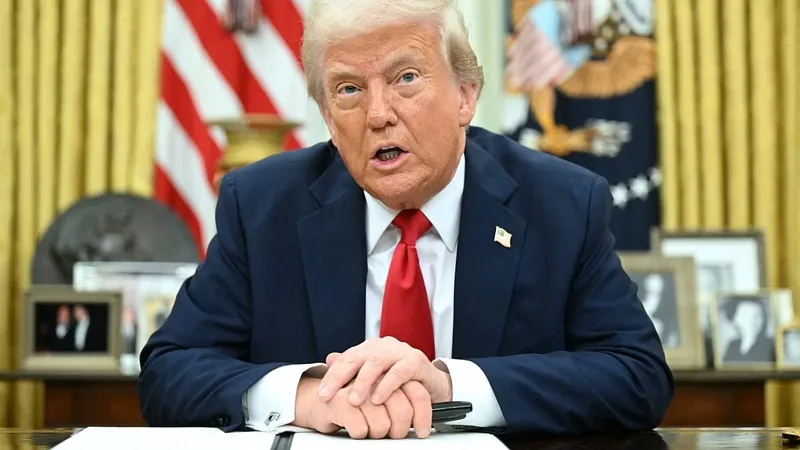
Trump Administration's Travel Ban for 43 Countries Faces Indefinite Delay—What This Means for Immigration Policy!
2025-04-01
Author: Wei
Introduction
In a surprising turn of events, the Trump administration has indefinitely delayed plans to impose a travel ban on foreign nationals from 43 countries, which has drawn significant attention and controversy.
Background of the Travel Ban
The initial directive stemmed from an executive order issued by President Trump on January 20, aiming to enhance security vetting for foreigners seeking to enter the United States. The order signaled a tough stance on national security, with an emphasis on scrutinizing potential threats before granting entry.
Current Status of the Ban
In mid-March, the White House released a memo categorizing these countries and specifying sanctions for nations with ties to Russia. However, the execution of these plans has hit a snag as the State Department has repeatedly missed deadlines for submitting crucial recommendations on the proposed travel restrictions.
Originally due on March 21, the State Department's report is still in progress, according to spokeswoman Tammy Bruce. “We’re diligently working on what the executive order requires regarding security and vetting standards, not travel bans,” Bruce clarified, emphasizing that while there is no set deadline, the process is very much ongoing.
Visa Program Review
Recent statements from the State Department indicate they are committed to fulfilling the president's directive, conducting a comprehensive review of all visa programs as mandated by Executive Order 14161. This review encompasses a range of nations, with a particular focus on those that may pose security concerns.
Categories of Countries
Countries identified in the memo have been categorized into three groups: full visa suspensions, partial suspensions impacting various visa types, and those that will have 60 days to rectify deficiencies to avoid stricter measures. Among the nations facing full ban measures are Afghanistan, Cuba, Iran, and North Korea, as these countries have been associated with significant security issues.
Possible Changes and Speculations
While the memo has not yet been finalized, a source indicates that ongoing discussions may alter the list before it receives official approval from top administration officials, including Secretary of State Marco Rubio. The list appears to echo previous controversial travel bans tied to Trump's first term, often referred to as the "Muslim ban," persisting concerns that similar political motivations underscore the administration’s current policies.
Implications of Immigration Controls
As Trump continues to tighten immigration controls at the start of his second term, he has hinted at extending restrictions to countries like Gaza, Libya, Somalia, Syria, and Yemen, all deemed threats to U.S. security. This determination comes amid a backdrop of rising global tensions, with the president warning that failure to negotiate peace regarding the Ukraine conflict may lead to World War III—an alarming possibility that involves the threat of nuclear warfare.
Impact on Visa Holders
Although individuals from these identified countries may face obstacles, it remains unclear how the administration will treat existing visa holders or green card holders amidst these newly proposed regulations. The administration faces mounting scrutiny over whether security protocols are reasonably applied or reflect systemic biases, particularly against Muslim-majority nations.
Conclusion and Future Considerations
This delay could potentially lead to further conversations surrounding immigration reform and national security, prompting many to question the future of travel regulations to the U.S. As the situation continues to evolve, observers are left to speculate on whom this policy will affect and how it reflects the broader dynamics of U.S. foreign policy and national security strategy.
Stay tuned for updates as this story develops—could these delays signal a shift in Trump's infamous immigration policies?



 Brasil (PT)
Brasil (PT)
 Canada (EN)
Canada (EN)
 Chile (ES)
Chile (ES)
 Česko (CS)
Česko (CS)
 대한민국 (KO)
대한민국 (KO)
 España (ES)
España (ES)
 France (FR)
France (FR)
 Hong Kong (EN)
Hong Kong (EN)
 Italia (IT)
Italia (IT)
 日本 (JA)
日本 (JA)
 Magyarország (HU)
Magyarország (HU)
 Norge (NO)
Norge (NO)
 Polska (PL)
Polska (PL)
 Schweiz (DE)
Schweiz (DE)
 Singapore (EN)
Singapore (EN)
 Sverige (SV)
Sverige (SV)
 Suomi (FI)
Suomi (FI)
 Türkiye (TR)
Türkiye (TR)
 الإمارات العربية المتحدة (AR)
الإمارات العربية المتحدة (AR)